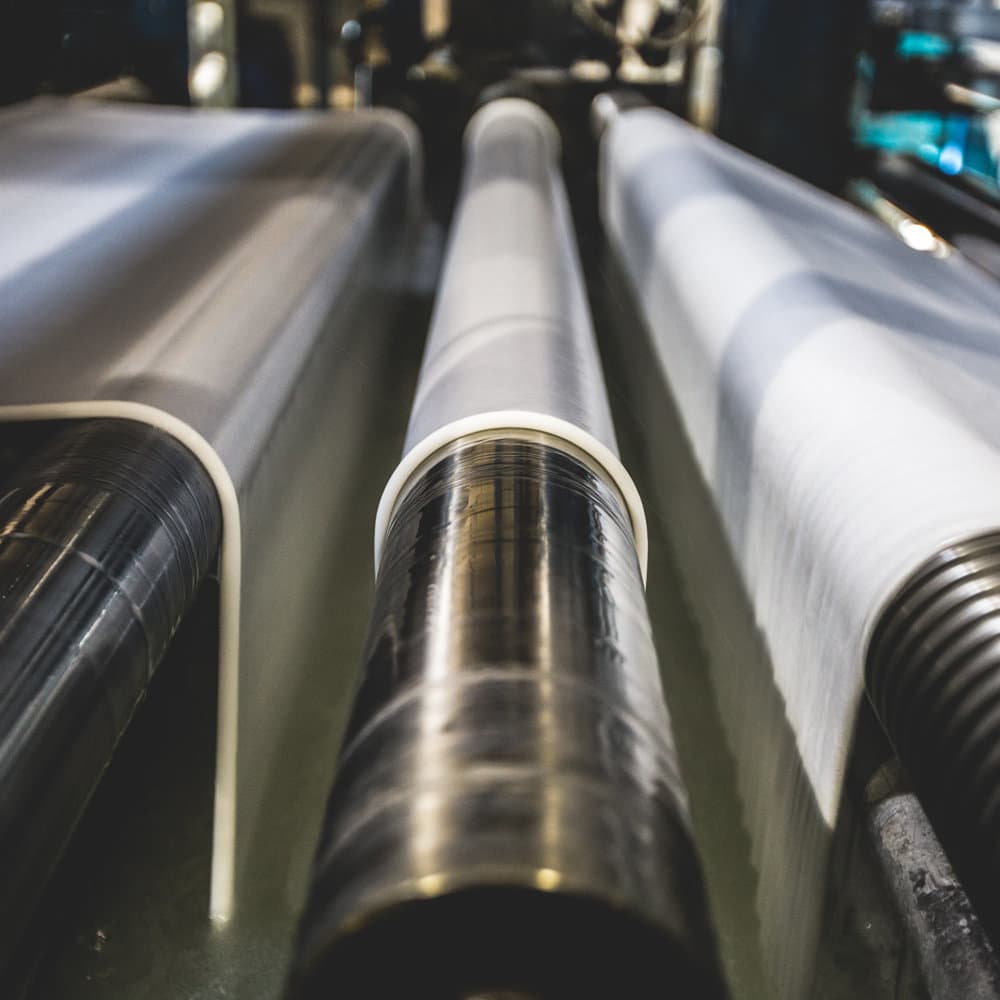2019: Year in review
Sustainability Report
2019: Year in review

Big companies report their profits in quarterly earnings reports. We think companies should be accountable for more than just profits. Here’s a look at what we were up to in 2019.
Sustainability Report
2019: Year in review

Big companies report their profits in quarterly earnings reports. We think companies should be accountable for more than just profits. Here’s a look at what we were up to in 2019.
Our sustainability report card
We’re never done challenging ourselves to evolve and be better. So we decided to work with a smart group of people at Eco-Age and have them evaluate us across twelve different areas of sustainability. It’s kind of like getting a fancy report card.


*Eco-Age also evaluated a bunch of other brands. No one scored higher than 50%, so as an industry and here at Reformation, we have a lot of work to do.

*Eco-Age also evaluated a bunch of other brands. No one scored higher than 50%, so as an industry and here at Reformation, we have a lot of work to do.
2020 priorities
So now what? While we’re super proud to be rated as leaders in Climate Action, we still have a lot of work to do. Here are some things we’re focusing on this year, and you can also check out our framework to learn more about our goals and programs for the next few years.
Corporate Governance - We’re starting an internal Sustainability Advisory Board to make sure we’re putting our resources in the right places.
Human Rights - We’re working towards becoming an affiliate of the Fair Labor Association to show our commitment to transparency and accountability.
Use of Chemicals - We’ll be rolling out environmental, compliance, and efficiency assessments with our key printing and dyeing partners. For those suppliers that need extra support, we’ll be working to provide comprehensive tools to help them build efficiency and management systems to improve.
Packaging - We’re reducing our packaging usage whenever possible and sourcing plastic-free options.
Community & Giving - We’re continuing to promote customer activism & advocacy for critical sustainability issues.
Use of Chemicals - We’ll be rolling out environmental, compliance, and efficiency assessments with our key printing and dyeing partners. For those suppliers that need extra support, we’ll be working to provide comprehensive tools to help them build efficiency and management systems to improve.
Packaging - We’re reducing our packaging usage whenever possible and sourcing plastic-free options.
Community & Giving - We’re continuing to promote customer activism & advocacy for critical sustainability issues.
Supply Chain Traceability - We’re piloting traceability programs to ensure product integrity, understand our impacts, and help build relationships throughout our supply chain.
Climate Action - We’re developing guidance material for our suppliers and store operations teams to further reduce their energy and water use and waste generation.
Employee Diversity and Inclusion - We’re developing a formal policy, reporting on our current state and progress, and doing unconscious bias training.
Product Environmental Footprint - We’re continuing to innovate and expand our circularity programs.
Operational Environmental Footprint - We’re putting together a green building / operations guidance for stores.
Climate Action - We’re developing guidance material for our suppliers and store operations teams to further reduce their energy and water use and waste generation.
Employee Diversity and Inclusion - We’re developing a formal policy, reporting on our current state and progress, and doing unconscious bias training.
Product Environmental Footprint - We’re continuing to innovate and expand our circularity programs.
Operational Environmental Footprint - We’re putting together a green building / operations guidance for stores.

Carbon is Canceled
Arcadia Power × Reformation
Electric power accounts for about 25% of all CO2 emissions in the US, so we partnered with
Arcadia Power to support wind energy projects.
Switch to wind energy for a $100 Ref credit.
2019 Impact:
655
people enrolled
1,388,735 estimated kwh of annual wind power generated
That’s equivalent to taking 208 cars off the road.
Climate Credits
You can now
purchase Climate Credits –aka carbon offsets–on our site. Your Climate Credit purchase goes directly to support Gold Standard verified carbon offset projects through
NativeEnergy that help balance your personal carbon footprint.
2019 Impact:
1,383
metric tons of total CO2 offset
That’s equivalent to taking 294 cars off the road.

Never not circulating
In 2019, we recirculated 484,751 garments* which is the equivalent to:
3,833 metric tons of C02
24,000,000 gallons of water
301 metric tons of waste
We’ve already beat the goal we set in 2018 to recycle 500,000 garments, so we’ll be setting new targets to keep pushing for better.
*This includes RefRecycling, RefVintage, vintage fairs, Rent-the-Runway, and thredUP.
3,833 metric tons of C02
24,000,000 gallons of water
301 metric tons of waste
We’ve already beat the goal we set in 2018 to recycle 500,000 garments, so we’ll be setting new targets to keep pushing for better.
*This includes RefRecycling, RefVintage, vintage fairs, Rent-the-Runway, and thredUP.
Signed on with Canopy
In 2019, we started working with the environmental non-profit group Canopy to ensure all our forest products, such as viscose, are Ancient and Endangered Forest free. We’re committed to only sourcing from forests that are conserved, protected, and restored. Check out our Sustainable Forests Commitment.
Getting a Climate Neutral Certification
Getting a Climate Neutral Certification
We’ve been 100% carbon-neutral since 2015, but in 2019 we started working with Climate Neutral. Through their rigorous certification program, Climate Neutral verifies a company like us has achieved net-zero carbon emissions. It's basically like getting a fancy seal of approval, which we’re working towards for 2020.
Joined the Jeans Redesign Project
We joined the Jeans Redesign project by the Ellen MacArthur Foundation's Make Fashion Circular initiative. This means our teams are designing with circularity in mind when it comes to durability, material health, recyclability, and traceability. By 2021, the majority of our jeans will meet high durability criteria, be made from regenerative or organic materials, and use zero toxic chemical processes.
Commitment to Responsible Recruitment
We signed the AAFA/FLA Apparel & Footwear Industry Commitment to Responsible Recruitment to proactively address potential forced labor risks for migrant workers in the global supply chain.
California Stores are Green Business Certified
Our six California retail stores and headquarters are now green business certified, which basically means we’re operating to improve energy savings, water efficiency, resource stewardship, and reducing CO2 emissions. But our efforts don’t stop there–we are working on tackling this in all of our stores.


Living wage
Our goal for 2019 was to have 100% of our team meet or exceed LA’s living wage (as defined by MIT¹). We ended the year with 96% of our Factory and DC teams earning a living wage. We’re on track to get to 100% in early 2020 for all Reformation teams—including retail—and will continue to do annual increases to keep up with the standard.
Our goal for 2019 was to have 100% of our team meet or exceed LA’s living wage (as defined by MIT¹). We ended the year with 96% of our Factory and DC teams earning a living wage. We’re on track to get to 100% in early 2020 for all Reformation teams—including retail—and will continue to do annual increases to keep up with the standard.


Traceability
Traceability is about knowing where our things come from. We want to be able to answer “who made our clothes” at every level of the supply chain to ensure positive environmental and social impacts of our stuff. Our goal for 2019 was to reach 100% traceability into our Tier 1 & 2 suppliers. We made it! Here’s a quick breakdown of our supply chain mapping progress in Q4².


But we still have a lot of work to do – supply chains are fragmented and complex. We'll continue to focus on developing relationships further down the supply chain (Tiers 3+) to ensure fair, safe, and healthy conditions for everyone behind your Ref stuff.
Factories
We’re committed to making clothes with a smaller environmental impact in places that treat workers well. We require all our direct cut, sew & finish manufacturing partners to adhere to our Code of Conduct (basically our requirements for ethical operations), and be monitored for compliance and continuous improvement.

We host tours of our factory in Los Angeles (we’ve hosted over 607 guests in 2019!) so you can see it IRL and meet the people who make your clothes. To save your spot, email us at love@thereformation.com.

Based on % volume

Sexy Math
RefScale tracks our environmental footprint by adding up the pounds of carbon dioxide emitted, gallons of water used, and pounds of waste generated. Then we calculate how much Reformation saves compared to conventional clothes bought in the US.


¹Living Wage is referencing “1 adult + 0 children”. Calculated as total compensation (regular + overtime + bonus) / total hours worked.
²Traceability and fiber performance are calculated by fabric count for the following categories: apparel, lingerie, shoe uppers, shoe linings, and bags. This does not include other shoe components or trims yet and excludes all deadstock materials.
³Clean chemistry statistics are calculated by unique printer, dyer and tannery count. Certifications included in this total are Oeko-Tex Standard 100, Bluesign, Global Organic Textile Standard (GOTS), Global Recycled Standard (GRS). Calculated for facilities that were used in Q4 2019.

